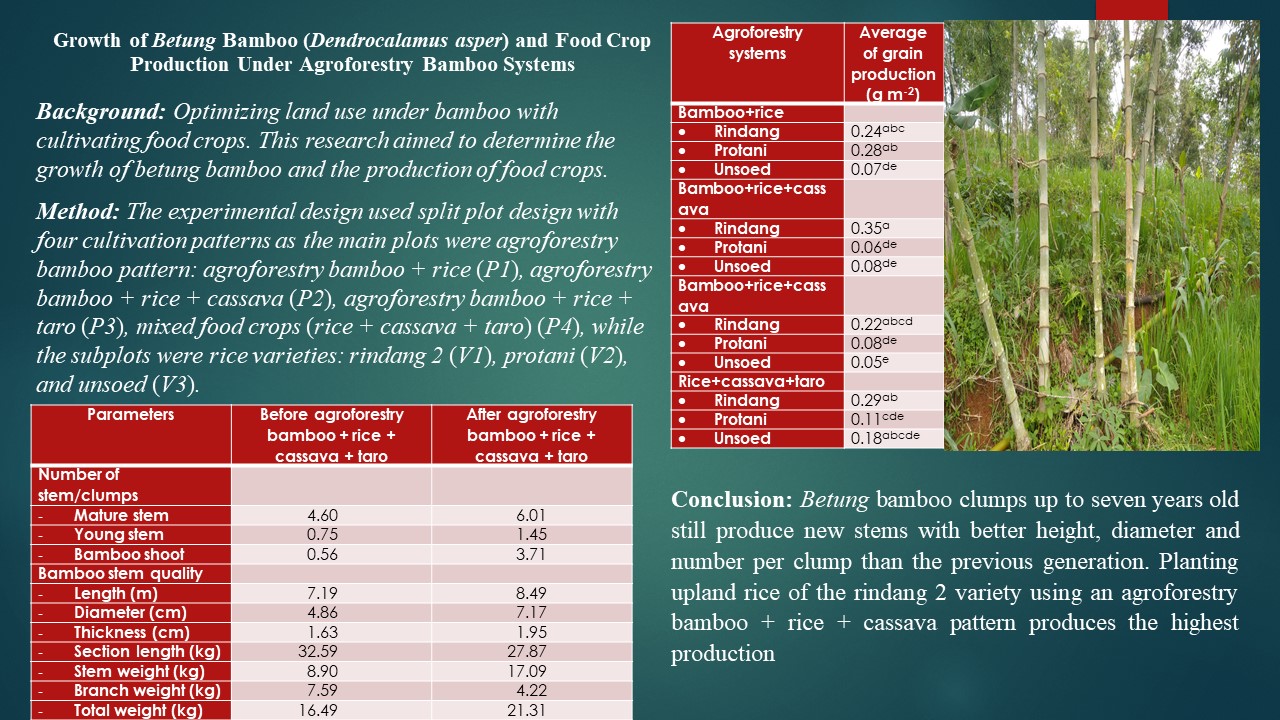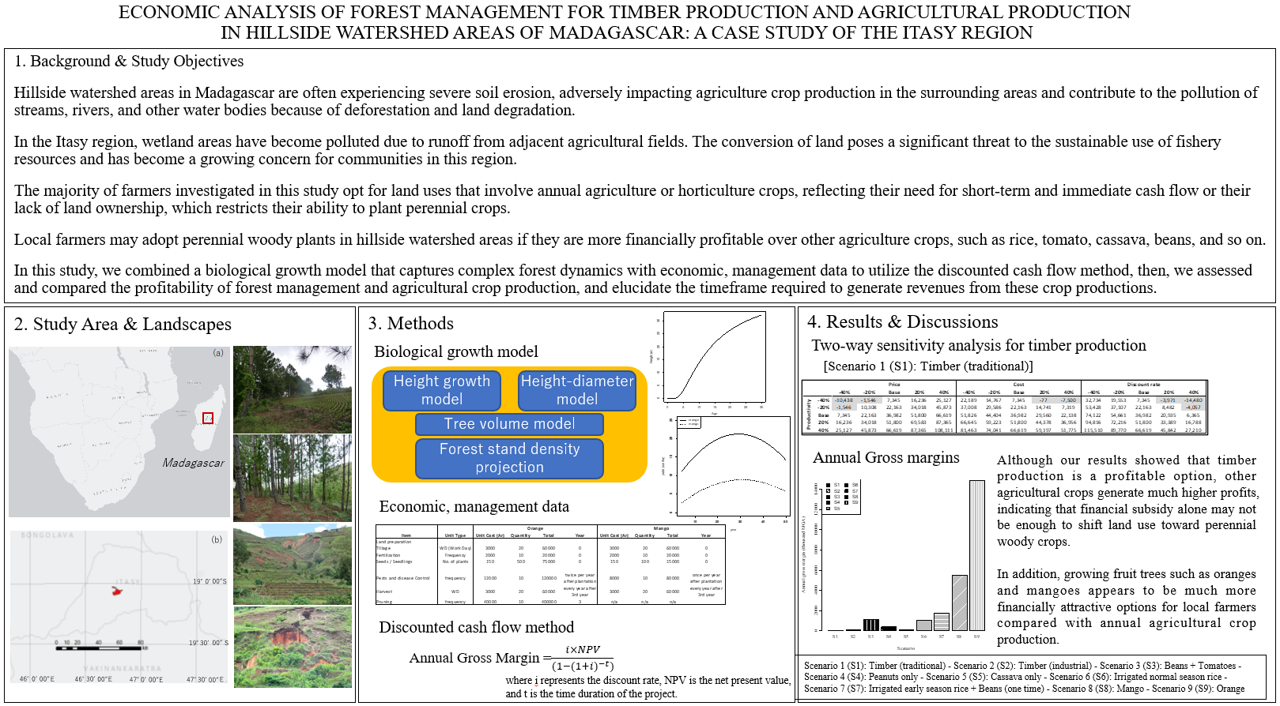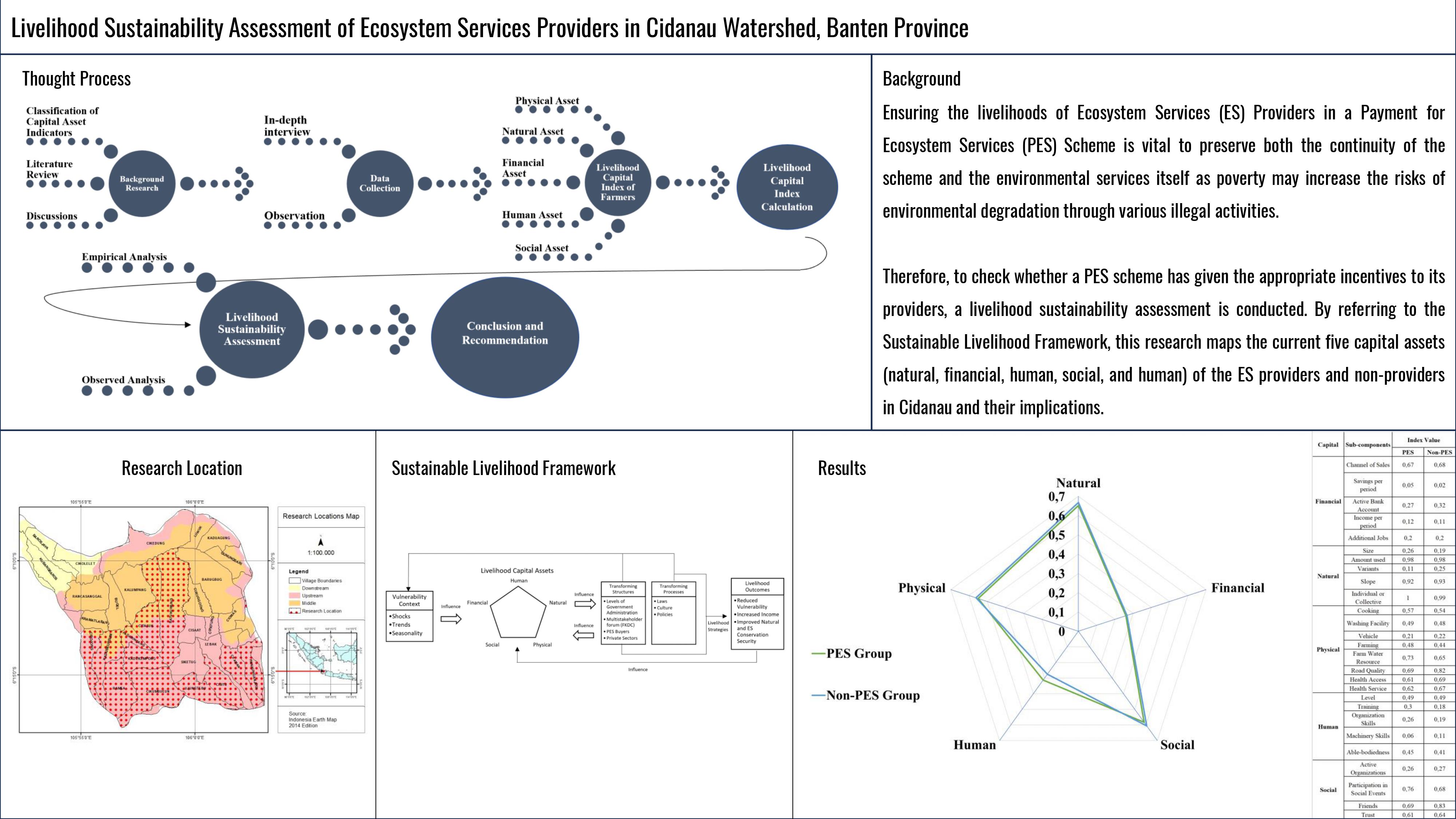Food Security Status in Agroforestry Landscapes of Way Betung Watershed, Indonesia and Molawin Dampalit Sub Watershed, Philippines
Abstract
Indonesia and Philippines are homes of biodiversity in Southeast Asia. In recent years, however, there has been a decline in biodiversity brought about by land use change. This condition poses threat on the food security of communities around the watersheds. The type and volume of main food items depend on the ecological and physiological conditions of the watersheds, in this case, Way Betung and Molawin Dampalit. When edible food is sufficient and available in an area, there is higher livelihood that the communities are food secured. This paper argues based on research which has been conducted in May to November 2015 that the food security of communities in the selected agroforestry landscapes in Way Betung and Molawin Dampalit have moderate. Levels of its food security based on four dimensions, namely: food availability, food accessibility, food stability and food utilization. Amounted 261 Indonesia farmer’s respondents and 106 Philippine’s respondents mentioned that the farm households generally practice agroforestry where the production of short-term and medium-term agricultural crops, woody perennials and livestock are deliberately combined. The type of crops grown by the farm households contribute to the level of food security.
References
Abiodun, A. O., Aremu, B. R., & Alamu, O. P. (2018). Food utilization, nutrition, health and farming households's income: A critical review of literature. Journal of Human Ecology, 56(12), 171–182. https://doi.org/10.1080/09709274.2016.11907053
Arifin, M., & Saliem, H. P. (2017). Pola konsumsi pangan pokok di beberapa propinsi di Indonesia. Jurnal Penelitian Agro Ekonomi, 9(21), 86–95. https://doi.org/ 10.21082/fae.v9n2-1.1992.86-95
Aliber, M., & Hall, R. (2012). Support for smallhoder farmers in South Africa: Challenges of scale and strategy. Journal Development Southern Africa, 29(4), 548–562. https://doi.org/10.1080/0376835X.2012.715441
Baliton, R. S., Wulandari, C., Landicho, L. D., Cabahug, R. E. D., Paelmo, R. E., Comia, R. A., ... Castillo, A. K. S. A. (2017). Ecological services of agroforestry landscapes in selected watershed area in the Philppines and Indonesia. Biotropia, 24(1), 71–84. https://doi.org/10.11598/ btb.2017.24.1.621
Bene, C., Prager, S. D., Achicanoy, H. A. E., Toro, P. A., Lamotte, L., Cedrez, C. B., & Mapes, B. R. (2019). Understanding food systems drivers: Acritical review of the literature. Global Food Security, 23, 149–159. https://doi.org/10.1016/j.gfs.2019.04.009
Cornelio, D. L. (2010). Status and potential of the Peroryctidae family to improve food security in Papua New Guinea. Jurnal Manajemen Hutan Tropika, 16(3), 155–160.
de Castro, S. R. R., Barlow, J., Ferreira, J., Berenguer, E., Lees, A. C., Thomson, … Gardner, T. A. (2015). How pervasive is biotic homogenization in human-modified tropical forest landscapes?. Ecology Letters, 18, 1108–1118.
https://doi.org/10.1111/ele.12494
[FAO] Food Agriculture Organization. (2006). Policy Brief Food Security. June 2006 Issue 2. Rome. https://doi.org/10.1016/S1353-4858(06)70428-7
Hughes, A. C. (2017). Understanding the drivers of Southeast Asian biodiversity loss. Ecosphere, 8(1), 133. https://doi.org/10.1002/ecs2.1624
Iskandar, B. S., Iskandar, J., & Partasasmita, R. (2018). Strategy of the Outer Baduy community of South Banten (Indonesia) to sustain their swidden farming traditions by temporary migration to non-Baduy areas. Biodiversitas, 19(2), 453–464. https://doi.org/10.13057/biodiv/ d190212
Jamnadass, R., Place, F., Toquebiau, E., Malezieux, E., Miyuki, L., Sileshi, G. W., ... Dawson, I. K. (2013). Agroforestry, food and nutritional security. ICRAF Working Paper No. 170. Nairobi, World Agroforestry Centre. https://doi.org/10.5716/WP13054.PDF
Jones, A. D. (2017). Critical review of the emerging research evidence on agricultural biodiversity, diet diversity, and nutritional status in low- and middle-income countries. Nutrition Reviews, 75(10), 769–782. https://doi.org/10.1093/nutrit/nux040
Karmini, Sarminah, S., & Karyati. (2017). Economic analysis of groundnut (Arachis hypogaea) and soybean (Glycine max) as intercropping plants in two agroforestry systems. Biodiversitas, 18(2), 483–493. https://doi.org/10.13057/biodiv/d180206
Kebebew, Z. & Urgessa K. (2011). Agroforestry perspective in land use pattern and farmers coping strategy: Experience from Southwestern Ethiopia. World Journal of Agricultural Sciences, 7(1), 73–77.
Kompas. (2019). Indonesia negara ke-6 dengan kepunahan biodiversitas tertinggi. Jakarta: PT Gramedia. Retrieved from https://sains.kompas.com/read/2019/08/28/080900323/indonesia-negara-ke-6-dengan-kepunahan-biodiversitas-tertinggi
Long, J. (2013). Perceptions of the underrepresentation of women in agriculture and motives for movement into the industry. Honors Projects. 42. Retrieved from http://digitalcommons.iwu.edu/socanth_honproj/42
Magcale-Macandog, D. B., Ranola, F. M., Ranola, R. F., Ani, P. A. B., & Vidal, N. B. (2010). Enhancing the food security of upland farming households through agroforestry in Claveria, Misamis Oriental, Philippines. Agroforestry Systems, 79(3), 327–342. https://doi.org/10. 1007/s10457-009-9267-1
Mbow, C., Noordwijk, M. V., Luedeling, E., Neufedt, H., Minang, PA, & Kowero, G. (2014). Agroforestry solutions to address food security and climate change challenges in Africa. Current Opinion in Environmental Sustainability, 6, 61–67. https://doi.org/10.1016/ j.cosust.2013.10.014
Mota, A. A., Lachore, S. T., & Handiso, Y. H. (2019). Assessment of food insecurity and its determinants in the rural households in Damot Gale Woreda, Wolaita zone, Southern Ethiopia. Agriculture and Food Security, 8, 11 https://doi.org/10.1186/s40066-019-0254-0
Sarvade, S., & Singh, R. (2014). Role of agroforestry in food security. Popular Kheti, 2(2), 25–29.
Setiajiati, F., Hardjanto, & Hendrayanto. (2017). Strategies of community empowerment to manage protection forest sustainably. Jurnal Manajemen Hutan Tropika, 23(2), 71–80.
https://doi.org/10.7226/jtfm.23.2.71
Smith, O., Wanga, J., & Carbonea, C. (2018). Evaluating the efect of forest loss and agricultural expansion on sumatran tigers from scat surveys. Biological Conservation, 221, 270–278. https://doi.org/10.1016/j.biocon.2018.03.014
Tanaka, T., & Karapinar, B. (2019). How to improve world food supply stability under future uncertainty: Potential role of WTO regulation on export restrictions in rice. Journal of Food Security, 7(4), 129–150. https://doi.org/10.12691/jfs-7-4-5
Tolentino, L. L., Landicho, L. D., Luna, C. C. D., & Cabahug, R. E. D. (2010). Case study: Agroforestry in the Philippines. In L. T. Constance (Ed.), Routledge Handbook of Climate Change and Society. London: Routledge Publishing.
Wulandari, C., Budiono, P., Yuwono, S. B., & Herwanti, S. (2014). Adoption of agro-forestry patterns and crop systems around Register 19 Forest Park, Lampung Province, Indonesia. Jurnal Manajemen Hutan Tropika, 20(2), 86–93. https://doi.org/10.7226/ jtfm.20.2.86
Wulandari, C., & Budiono, P. (2015). Food security under partnership scheme at Production Forest Register 42 Way Kanan, Lampung Province. Paper presented at The USR International Seminar on Food Security (UIFS). Universitas Lampung, Bandar Lampung, 23–24 August 2016.
Wulandari, C., Bintoro, A., Rusita, Santoso, T., Duryat, Kaskoyo, H., ... Budiono, P. (2018). Community forestry adoption based on multipurpose tree species diversity towards to sustainable forest management in ICEF of University of Lampung, Indonesia. Biodiversitas, 19(3), 1102–1109. https://doi.org/ 10.13057/biodiv/d190344
Authors

This work is licensed under a Creative Commons Attribution 4.0 International License.
Jurnal Manajemen Hutan Tropika is an open access journal which means that all contents is freely available without charge to the user or his/her institution. Users are allowed to read, download, copy, distribute, print, search, or link to the full texts of the articles in this journal without asking prior permission from the publisher or the author. This is in accordance with the Budapest Open Access Initiative (BOAI) definition of open access.








